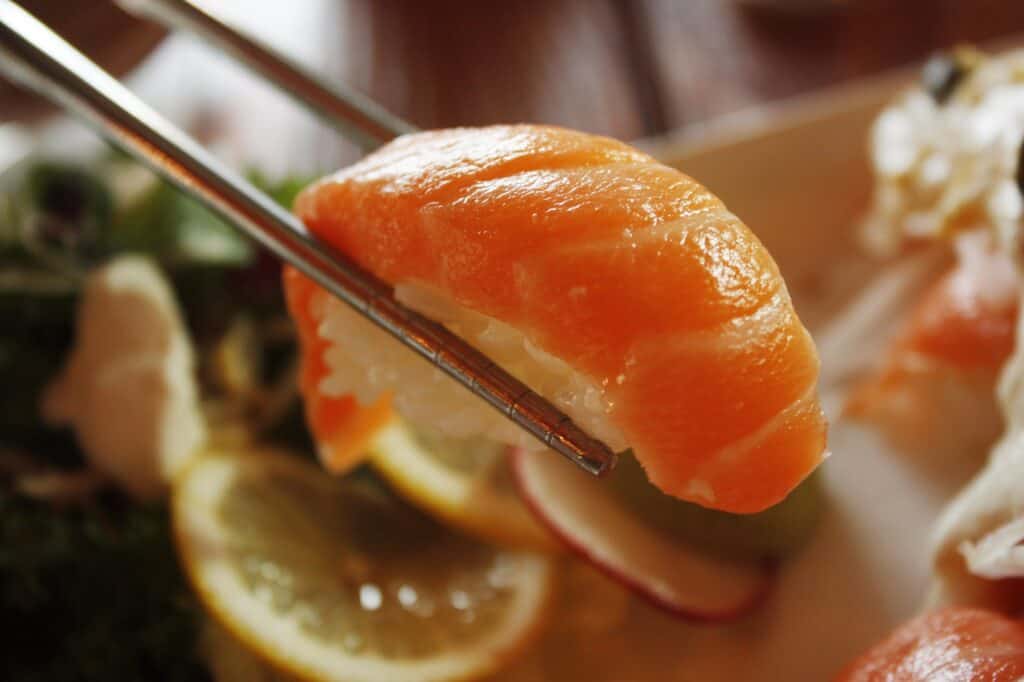If food isn’t stored correctly, it can go bad quickly, which is especially true for raw meats. Despite eating salmon raw or smoked on sushi, it can still go bad if not eaten the same day it was prepared. If you’re wondering can you eat sushi the next day, learn more about storing it properly to have it fit for leftovers.
The short answer is yes, you can eat sushi the next day. However, it depends on the type and storing method – if you have raw fish in your meal, it’d be best to finish it within the next 24 hours. If the sushi is vegetarian, you can even store it out of the fridge since rice has a better texture when it isn’t in cold environments.


If you currently have some leftover sushi and don’t know how to store it or if it should be left for tomorrow, these tips may help you decide what to do.
Can You Eat Sushi the Next Day If You Have Leftovers?
In short, yes, you can eat sushi the next day. However, it depends on where you got it and how long it’s been in the fridge. If you ate at a restaurant and asked for the remaining food to be packed to go, you can store it in the refrigerator for up to 24 hours.
Suppose you ordered tuna nigiri and salmon sashimi. These are raw pieces of meat that should not be left out of the fridge for long since bacteria can grow on them. If you’ve ever seen how they store raw fish in stores and restaurants, you’ll remember these big slices on top of a pile of ice. Refrigerated is best.
You can eat vegetarian sushi the next day, too. It’s possible to keep it outside of the refrigerator as there’s no ingredient on it to pick up bacteria. However, the rice taste could be off the next day if left out, so it’s best to store it at around 41 degrees Fahrenheit.
Is Sushi Good the Next Day and Can You Eat Day Old Sushi?
Have you ever found yourself wondering if it’s safe to eat leftover sushi the next day? We’ve all been there, asking ourselves “Can I eat leftover sushi” or “Can I eat sushi the next day”. These are common questions we ask when we don’t want to waste food.
When considering whether it’s safe to eat sushi the next day, many people are hesitant because they know that raw fish has a short shelf life before it goes bad. So can sushi be eaten the next day? The good news is that sushi is generally ok to eat the next day if it was stored correctly overnight in the refrigerator.
What if you can’t eat your sushi the next day? Can you eat 2 day old sushi or should you throw it out? Sashimi and other raw sushi can be stored in the refrigerator for 1-2 days, while cooked sushi keeps for 3–4 days. More than two hours should not be spent keeping either type at room temperature.
Does Sushi Go Bad? How to Tell Your Leftovers Are No Good
When it comes to how long is sushi good for, the answer depends. Sushi has many components that can affect whether is it safe to eat sushi the next day. Each roll and nigiri piece has at least two ingredients, but one will always be rice. This staple grain is an excellent choice for people sensitive to gluten, and it’s healthy. However, it can go bad and fast.
Rice gets hard in the refrigerator and no longer tastes soft and chewy since the cold dehydrates it but preserves the raw fish; if you’re not too squeamish about the taste of day-old rice or any food, you’ll be good.
Preserving maki rolls, the ones with nori seaweed on the outside, is also possible in a refrigerator, but the outer layer can lose its crunch and freshness the next day. The seaweed could be chewier and a bigger mouthful; still, the taste isn’t bad and won’t damage the structure or texture of sushi.
Do a Visual and a Smell Check Before Diving Back Into Your Sushi
The best way to determine is day old sushi safe is to properly check the food. When deciding whether or not to eat sushi the next day, you should also consider any potential health risks associated with doing so. The best way to check if your sushi’s gone bad is to do a smell and eye test.
Firstly, look at the portions, and then use your nose to sniff out any dodginess. Here’s a list of things to look out for when checking day-old sushi:
- Is there discoloration on the fish? Salmon has a naturally vibrant orange color, but if you see that color fading on parts of the fish, it may be best to get rid of it. Tuna is usually a vibrant red, but if it starts looking pinkish, it’s not good anymore,
- Can you see goo or slime on the rice? In the fridge, rice can get dehydrated, but any other way of storing it can leave it looking like a pile of mush. If there’s any goo or the rice is sticky to the touch, throwing it out is best,
- Smell the fish and check if it has a funky smell. Not in a fish kind of way, but fishier. Fresh fish doesn’t naturally smell too strongly, but the worse its quality is, the smell worsens with it. If you can smell more fish than usual on your piece of sashimi, don’t risk getting a stomach bug,
- Rice doesn’t smell at all when it’s cooked; it’s a neutral grain. However, it can develop a stale fragrance when it’s been kept uneaten for too long. If your rice smells, toss it out.
When Should You Refrigerate Leftover Sushi?
If you do have leftover sushi, it should be refrigerated as soon as possible once you are done eating it—preferably within two hours after finishing your meal. Keeping your leftover sushi in a well-sealed container with ice packs can help preserve its freshness and make sure that bacteria doesn’t grow on it while it sits in your fridge overnight. If you plan on eating your leftovers within 24 hours of making them, then they should still be safe to eat as long as they were stored properly in the fridge.
The most crucial thing to keep in mind is to keep it refrigerated since sushi with a raw component, such as spicy tuna rolls and sashimi (which are essentially just raw fish slices), can actually encourage the growth of bacteria.

Curious to know more about other Japanese delicacies? Read also :
What Is Tobiko?
Hamachi vs Sashimi
Is Tempura Shrimp?
Are Cherry Blossoms Edible?
Are Sushi Rolls Cooked?
How To Make Crab For Sushi
If You Store Leftover Sushi Properly, You’ll Prolong Its Shelf-Life
Can you eat leftover sushi or should you throw it out? There’s nothing wrong with the plastic or styrofoam box you get for your leftover sushi, but these restaurant packages typically aren’t airtight. If you transfer your sushi to-go into an airtight container when you get home, you’ll find that it’s done its job perfectly well the next day. Airtight plastic containers can sometimes preserve taste so well that the sushi rolls seem to have a better taste afterward.
Plastic Wrap Is Your Friend In Avoiding Many Kitchen Disasters
To fully maximize the potential freshness of your day-old sushi, use plastic wrap. When you get the rolls or nigiri (or both) out of the restaurant packaging, wrap it in plastic and store it in an airtight container. This way, the sushi will have a prolonged shelf life and fresh taste.
One thing to remember before wrapping the sushi with plastic is to check for any excess water or dampness on it. Make sure it’s dry, as the water can speed up the molding process and develop bacteria. Your sushi will be excellent tomorrow, so take care of it well until then.
It’s OK If You Don’t Finish Your Sushi Meal on the Same Day
Now that you know how to store the sushi you brought from the restaurant, you can follow these tips and check it out tomorrow. If you’re just about to head out for some of this Japanese delicacy, order as much as you like and get the leftovers because you’ll be prepared to keep them in the fridge and preserve their freshness.